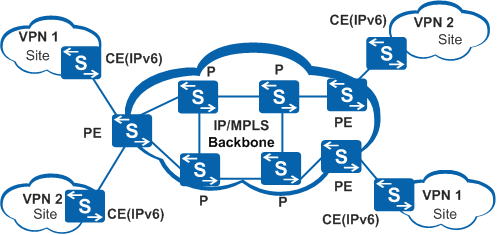BGP/MPLS IPv6 VPN Extension
As users start to deploy IPv6 architecture on their networks, requirements for IPv6 interworking between VPN sites are increasing. BGP/MPLS IPv6 VPN extension enables IPv4 backbone networks to provide IPv6 VPN services for users. This solution is also called 6VPE.
Figure 1 shows an example of a BGP/MPLS IPv6 VPN extension model.
In Figure 1, CE and PE devices on VPNs run IPv6 protocols, such as BGP4+, OSPFv3, IS-IS IPv6, or static IPv6 routing. The backbone network runs IPv4 protocols. The PE devices must support both IPv4 and IPv6 protocols. On a PE device, interfaces connected to CE devices run IPv6 protocols and interfaces connected to the backbone network run IPv4 protocols.
VPN-IPv6 routes are advertised on the backbone network through MP-BGP. IPv6 packets are identified using MPLS labels. LSP or MPLS TE tunnels are established on the backbone network to transmit private network data. Route advertisement, label distribution, and tunneling mechanism in BGP/MPLS IPv6 VPN are the same as those in BGP/MPLS IPv4 VPN.
